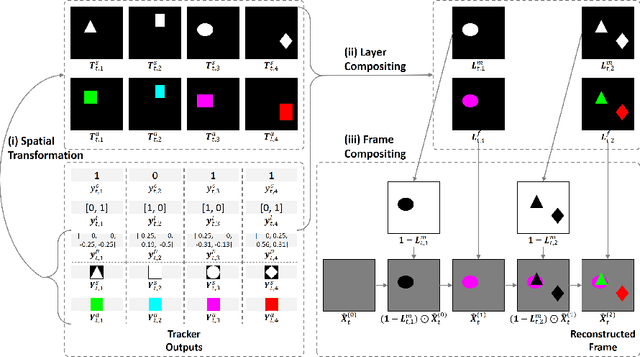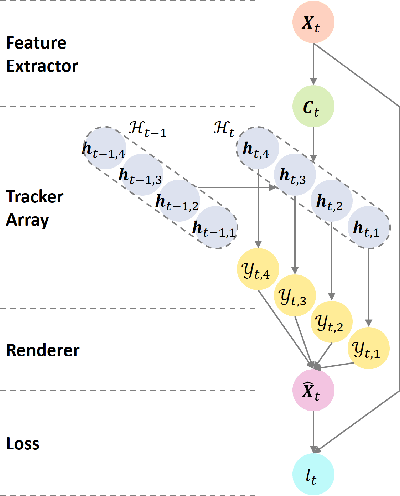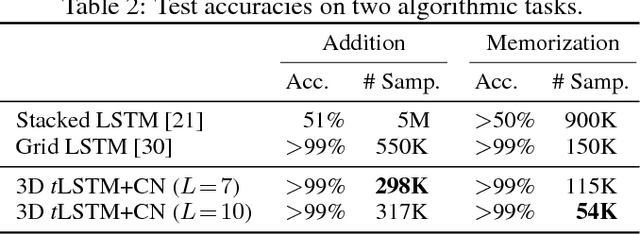Hangen He
Tracking by Animation: Unsupervised Learning of Multi-Object Attentive Trackers
Sep 10, 2018



Abstract:Online Multi-Object Tracking (MOT) from videos is a challenging computer vision task which has been extensively studied for decades. Most of the existing MOT algorithms are based on the Tracking-by-Detection (TBD) paradigm combined with popular machine learning approaches which largely reduce the human effort to tune algorithm parameters. However, the commonly used supervised learning approaches require the labeled data (e.g., bounding boxes), which is expensive for videos. Also, the TBD framework is usually suboptimal since it is not end-to-end, i.e., it considers the task as detection and tracking, but not jointly. To achieve both label-free and end-to-end learning of MOT, we propose a Tracking-by-Animation framework, where a differentiable neural model first tracks objects from input frames and then animates these objects into reconstructed frames. Learning is then driven by the reconstruction error through backpropagation. We further propose a Reprioritized Attentive Tracking to improve the robustness of data association. Experiments conducted on both synthetic and real video datasets show the potential of the proposed model.
Wider and Deeper, Cheaper and Faster: Tensorized LSTMs for Sequence Learning
Dec 13, 2017



Abstract:Long Short-Term Memory (LSTM) is a popular approach to boosting the ability of Recurrent Neural Networks to store longer term temporal information. The capacity of an LSTM network can be increased by widening and adding layers. However, usually the former introduces additional parameters, while the latter increases the runtime. As an alternative we propose the Tensorized LSTM in which the hidden states are represented by tensors and updated via a cross-layer convolution. By increasing the tensor size, the network can be widened efficiently without additional parameters since the parameters are shared across different locations in the tensor; by delaying the output, the network can be deepened implicitly with little additional runtime since deep computations for each timestep are merged into temporal computations of the sequence. Experiments conducted on five challenging sequence learning tasks show the potential of the proposed model.
Light Cascaded Convolutional Neural Networks for Accurate Player Detection
Sep 29, 2017



Abstract:Vision based player detection is important in sports applications. Accuracy, efficiency, and low memory consumption are desirable for real-time tasks such as intelligent broadcasting and automatic event classification. In this paper, we present a cascaded convolutional neural network (CNN) that satisfies all three of these requirements. Our method first trains a binary (player/non-player) classification network from labeled image patches. Then, our method efficiently applies the network to a whole image in testing. We conducted experiments on basketball and soccer games. Experimental results demonstrate that our method can accurately detect players under challenging conditions such as varying illumination, highly dynamic camera movements and motion blur. Comparing with conventional CNNs, our approach achieves state-of-the-art accuracy on both games with 1000x fewer parameters (i.e., it is light}.
Generalized Haar Filter based Deep Networks for Real-Time Object Detection in Traffic Scene
Oct 30, 2016



Abstract:Vision-based object detection is one of the fundamental functions in numerous traffic scene applications such as self-driving vehicle systems and advance driver assistance systems (ADAS). However, it is also a challenging task due to the diversity of traffic scene and the storage, power and computing source limitations of the platforms for traffic scene applications. This paper presents a generalized Haar filter based deep network which is suitable for the object detection tasks in traffic scene. In this approach, we first decompose a object detection task into several easier local regression tasks. Then, we handle the local regression tasks by using several tiny deep networks which simultaneously output the bounding boxes, categories and confidence scores of detected objects. To reduce the consumption of storage and computing resources, the weights of the deep networks are constrained to the form of generalized Haar filter in training phase. Additionally, we introduce the strategy of sparse windows generation to improve the efficiency of the algorithm. Finally, we perform several experiments to validate the performance of our proposed approach. Experimental results demonstrate that the proposed approach is both efficient and effective in traffic scene compared with the state-of-the-art.
Visual Saliency Based on Scale-Space Analysis in the Frequency Domain
May 06, 2016



Abstract:We address the issue of visual saliency from three perspectives. First, we consider saliency detection as a frequency domain analysis problem. Second, we achieve this by employing the concept of {\it non-saliency}. Third, we simultaneously consider the detection of salient regions of different size. The paper proposes a new bottom-up paradigm for detecting visual saliency, characterized by a scale-space analysis of the amplitude spectrum of natural images. We show that the convolution of the {\it image amplitude spectrum} with a low-pass Gaussian kernel of an appropriate scale is equivalent to such an image saliency detector. The saliency map is obtained by reconstructing the 2-D signal using the original phase and the amplitude spectrum, filtered at a scale selected by minimizing saliency map entropy. A Hypercomplex Fourier Transform performs the analysis in the frequency domain. Using available databases, we demonstrate experimentally that the proposed model can predict human fixation data. We also introduce a new image database and use it to show that the saliency detector can highlight both small and large salient regions, as well as inhibit repeated distractors in cluttered images. In addition, we show that it is able to predict salient regions on which people focus their attention.
 Add to Chrome
Add to Chrome Add to Firefox
Add to Firefox Add to Edge
Add to Edge